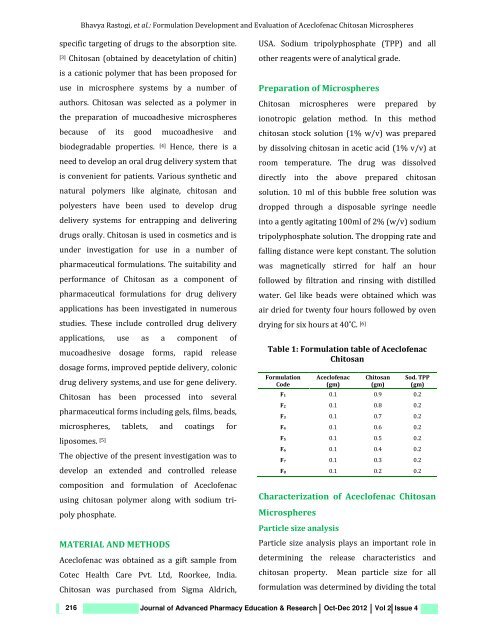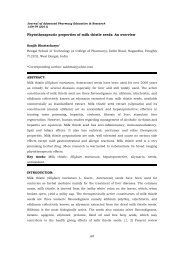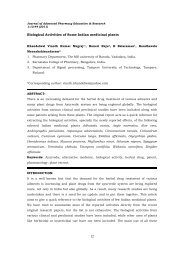Formulation Development and Evaluation of Aceclofenac ... - japer
Formulation Development and Evaluation of Aceclofenac ... - japer
Formulation Development and Evaluation of Aceclofenac ... - japer
Create successful ePaper yourself
Turn your PDF publications into a flip-book with our unique Google optimized e-Paper software.
Bhavya Rastogi, et al.: <strong>Formulation</strong> <strong>Development</strong> <strong>and</strong> <strong>Evaluation</strong> <strong>of</strong> Acecl<strong>of</strong>enac Chitosan Microspheres<br />
specific targeting <strong>of</strong> drugs to the absorption site.<br />
[3] Chitosan (obtained by deacetylation <strong>of</strong> chitin)<br />
is a cationic polymer that has been proposed for<br />
use in microsphere systems by a number <strong>of</strong><br />
authors. Chitosan was selected as a polymer in<br />
the preparation <strong>of</strong> mucoadhesive microspheres<br />
because <strong>of</strong> its good mucoadhesive <strong>and</strong><br />
biodegradable properties. [4] Hence, there is a<br />
need to develop an oral drug delivery system that<br />
is convenient for patients. Various synthetic <strong>and</strong><br />
natural polymers like alginate, chitosan <strong>and</strong><br />
polyesters have been used to develop drug<br />
delivery systems for entrapping <strong>and</strong> delivering<br />
drugs orally. Chitosan is used in cosmetics <strong>and</strong> is<br />
under investigation for use in a number <strong>of</strong><br />
pharmaceutical formulations. The suitability <strong>and</strong><br />
performance <strong>of</strong> Chitosan as a component <strong>of</strong><br />
pharmaceutical formulations for drug delivery<br />
applications has been investigated in numerous<br />
studies. These include controlled drug delivery<br />
applications, use as a component <strong>of</strong><br />
mucoadhesive dosage forms, rapid release<br />
dosage forms, improved peptide delivery, colonic<br />
drug delivery systems, <strong>and</strong> use for gene delivery.<br />
Chitosan has been processed into several<br />
pharmaceutical forms including gels, films, beads,<br />
microspheres, tablets, <strong>and</strong> coatings for<br />
liposomes. [5]<br />
The objective <strong>of</strong> the present investigation was to<br />
develop an extended <strong>and</strong> controlled release<br />
composition <strong>and</strong> formulation <strong>of</strong> Acecl<strong>of</strong>enac<br />
using chitosan polymer along with sodium tri-<br />
poly phosphate.<br />
MATERIAL AND METHODS<br />
Acecl<strong>of</strong>enac was obtained as a gift sample from<br />
Cotec Health Care Pvt. Ltd, Roorkee, India.<br />
Chitosan was purchased from Sigma Aldrich,<br />
USA. Sodium tripolyphosphate (TPP) <strong>and</strong> all<br />
other reagents were <strong>of</strong> analytical grade.<br />
Preparation <strong>of</strong> Microspheres<br />
Chitosan microspheres were prepared by<br />
ionotropic gelation method. In this method<br />
chitosan stock solution (1% w/v) was prepared<br />
by dissolving chitosan in acetic acid (1% v/v) at<br />
room temperature. The drug was dissolved<br />
directly into the above prepared chitosan<br />
solution. 10 ml <strong>of</strong> this bubble free solution was<br />
dropped through a disposable syringe needle<br />
into a gently agitating 100ml <strong>of</strong> 2% (w/v) sodium<br />
tripolyphosphate solution. The dropping rate <strong>and</strong><br />
falling distance were kept constant. The solution<br />
was magnetically stirred for half an hour<br />
followed by filtration <strong>and</strong> rinsing with distilled<br />
water. Gel like beads were obtained which was<br />
air dried for twenty four hours followed by oven<br />
drying for six hours at 40˚C. [6]<br />
Table 1: <strong>Formulation</strong> table <strong>of</strong> Acecl<strong>of</strong>enac<br />
Chitosan<br />
<strong>Formulation</strong><br />
Code<br />
Acecl<strong>of</strong>enac<br />
(gm)<br />
Chitosan<br />
(gm)<br />
Sod. TPP<br />
(gm)<br />
F1 0.1 0.9 0.2<br />
F2 0.1 0.8 0.2<br />
F3 0.1 0.7 0.2<br />
F4 0.1 0.6 0.2<br />
F5 0.1 0.5 0.2<br />
F6 0.1 0.4 0.2<br />
F7 0.1 0.3 0.2<br />
F8 0.1 0.2 0.2<br />
Characterization <strong>of</strong> Acecl<strong>of</strong>enac Chitosan<br />
Microspheres<br />
Particle size analysis<br />
Particle size analysis plays an important role in<br />
determining the release characteristics <strong>and</strong><br />
chitosan property. Mean particle size for all<br />
formulation was determined by dividing the total<br />
216 Journal <strong>of</strong> Advanced Pharmacy Education & Research Oct-Dec 2012 Vol 2 Issue 4





